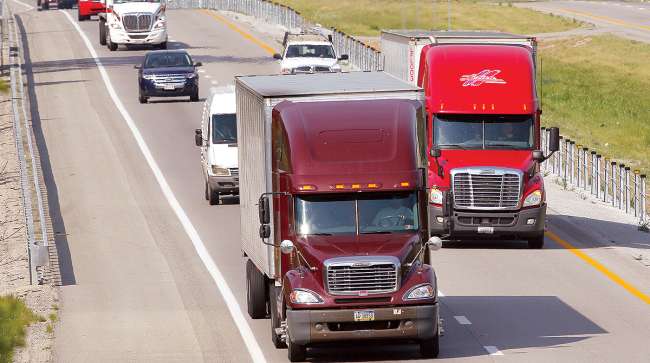ATA’s Tonnage Index Rises 1.3% for June

U.S. truck tonnage rose by 1.3% in June, compared with the same month in 2016, American Trucking Associations said July 18, with industry executives and analysts reporting steady, sustainable growth they expect to last into 2018.
Looking at the index from month-to-month shows more of a roller coaster pattern. From May to June, tonnage fell 4.3%, after a 6.9% surge from April to May.
The seasonally adjusted index was 138.5 last month, compared with 136.7 a year earlier. ATA measures tonnage as an index where business activity among for-hire carriers in the year 2000 equals a base level of 100.
“After such a large spike in May, it was not surprising to see the index give back some of those gains in June,” ATA Chief Economist Bob Costello said. “However, looking back at the second quarter as a whole, tonnage was up 0.8% over the first quarter, and 1.9% over the same quarter last year, so it was a solid three-month period.”
Costello said his overall freight outlook remains intact: “June’s slide does not change my belief that we will continue to see moderate, albeit at times choppy, growth in truck tonnage as the year continues.”
Looking at the raw tonnage figures, before seasonal adjustment, the June number was 144.3, or a 1% dip from the May level of 145.8.
About 70% of all U.S. freight, measured by weight, is carried on trucks, according to ATA statistics.
“Business is strong. Momentum feels like it is sustaining itself,” said Tonn Ostergard, chairman and CEO of truckload carrier Crete Carrier Corp. The corporation’s three operating companies haul a lot of consumer products — more staples than luxury goods — in dry and refrigerated vans. Crete ranks No. 35 on the Transport Topics Top 100 list of for-hire carriers in North America.
Ostergard said one of his biggest management challenges is balancing the strong demand from shippers with difficulty in finding enough drivers to operate all of the trucks requested.
“It’s like ‘A Tale of Two Cities,’ with the best of times and worst of times,” he said. “We don’t have the luxury of turning demand from customers on and off.”
The Crete companies have seen steady growth through the first half of this year, and Ostergard said he expects that will continue through this year and into early 2018 at least.
Less-than-truckload carrier Peninsula Freight Lines hauls general commodities throughout its network of 15 terminals in Idaho, Oregon and Washington, and business “is robust at this point, ahead of where we were last year,” company President Brent Vander Pol said.
“It just seems strong across the board, shipping from across our customer base,” Vander Pol said, adding that his company is at the right place at the right time.
“The Pacific Northwest is a good place to be now. There’s population growth, the tech sector is growing, and Boeing Co. is doing well,” he said. The aerospace company on its website says its has about 70,000 employees in the state.
Vander Pol expect business to remain good until the start of winter, which tends to diminish fourth-quarter business, but noted, “I don’t expect things to be too different in 2018.”
Economist Noël Perry, a partner with research firm FTR Intelligence, said the automotive sector is perhaps the only major shipper group which should be concerned. U.S. auto sales set back-to-back records in 2015 and 2016, and this year’s performance is below either of those years. “The bloom is off that market,” he said.
While July is usually a slow economic time of year, Perry said, “There is nothing in the federal economic data indicating sustained weakness.” The FTR forecast calls for continued economic growth in the second half of this year but at a slower pace than during the first half, he said.
Load board operator DAT Solutions said the truckload spot market is much hotter than contractual shipping.
“Spot truckload freight activity in June rallied to record highs for the number of available loads, while rates rose to their highest points in nearly two years,” the Beaverton, Ore., company announced July 12.
Mark Montague, DAT’s industry pricing analyst said the high demand for extra trucks is spread evenly among all three major truckload groups: dry and refrigerated vans and flatbeds.
Refrigerated improvement started in May and led to “a pretty good June,” Montague said, because of strong agricultural volumes out of California.
For flatbeds, the return of hydraulic fracturing, or fracking, for domestic oil and natural gas production has strengthened demand for their services, he said.
Montague said year-over-year spot market pricing was soft during the first quarter, with all three segments showing declines. But during the second quarter, dry van rates are up 2.8% relative to the 2016 second quarter, flatbed rates are up 3.2% and reefer rates rose by 1.2%.




